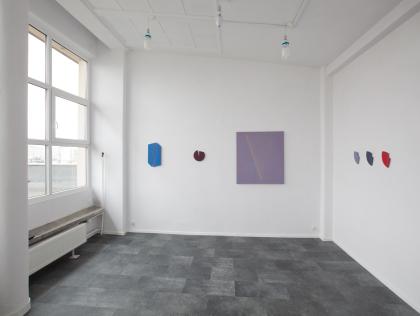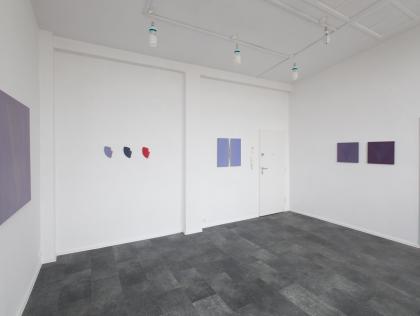
Olga Ząbroń — NO art space - Pomiędzy / In Between
NO art space / Lublańska 20/82 / Cracow / Poland
exibition pomiędzy / in between / Olga Ząbroń / 08.09-08.11.2023
The exhibition "pomiędzy/in between" inaugurated activity of a new space - artist run space - in Kraków. The artist transforms her workshop into a NO art space - a space dedicated to presenting art from non-objective area. It’s an original, curatorial project aimed at promoting creativity of artists operating in the broadly understood trend of objectless art.
The current exhibition is of personal nature. Dedicated to a special person, Kalina - the artist's mother.
When I first saw the works of Olga Ząbroń at a small but very well-constructed group exhibit at the Nuremberg House in Kraków, I had an epiphany. These works resonated so strongly with what I am looking for in art. They came so close to my idea of twenty-first-century abstract painting that at the next exhibit, this time larger, although I did not expect to see them there again - Olga Ząbroń’s paintings immediately caught my eye.
The art of Ząbroń has the power to remain in memory. Her paintings cannot be confused with the works of other artists. And although it immediately allows to classify itself as a geometric abstraction, with its slight deviations from the dogmatic order of geometry, it provokes an in-depth observation of its filigree
structure. It is worth taking a close and focused look at the artist’s compositions - then we will be within the range of the energy they generate. Energy is one of the key features of Olga Ząbroń’s art. It is born of the game of paradoxes that seem to drive the artist’s works.
Olga Ząbroń’s painting is based on clearly defined principles, yet it remains elusive, full of understatements.
It is stretched between a vast plane of color and the steady vibrations of groups of lines. Between the perfection of the geometric form and the barely perceptible disturbance of the harmony of its components. Between the silent surface of the canvas and the imaginary wall of sound, inscribed in the painting as in a musical score. Between the monotony of repetition and the uniqueness of color combinations.
Oppositions are the building blocks of this art. The abstract spaces between them are described by the artist as “gaps that are channels of flowing energy”.
Determined and intense in form, the work of Olga Ząbroń can also put you in a meditative mood. “The form of my paintings is to accumulate or release energy, create and discharge tensions.” (1)
The artist’s paintings are characterized by extraordinary spatiality. The viewer’s eye follows paths of lines deeper into the composition. The lines, always arranged in clearly defined order, create entire planes of mutually reacting forces. The planes seem to draw inside the picture or create the illusion of convexity; they multiply or lead our gaze beyond the picture.
The spatiality of Olga Ząbroń’s works proceeds in stages. The first type is the illusory depth created in the painting by delicate lines. The second stage is opening to space with the help of the shape of the image: this is the case in works based on the form of a circle, the fragments of which cut into the surroundings. Such a work is not a closed circuit; it does not accumulate energy within itself, but releases it outside.
Completely three-dimensional compositions - geometric forms which are closer to sculpture - arrangements of planes covered with abstract drawings, pulsating with changing rhythms.
Monumental works are of a special kind: large-format painting installations that allow us to experience the energy flowing from the works of Olga Ząbroń in an impactful way.
Thanks to the opening of the image to space, we are looking for the continuation of the form of the work beyond itself. This, in turn, provokes reflections on infinity and attempts to manifest it in art. The visual qualities of Olga Ząbroń’s geometric compositions make them a suggestive carrier of transcendent content.
The depth and spaciousness of Ząbroń’s works are inextricably linked with their luminosity. Some of the pictures at first glance overwhelm the color gamut, but after a while they reveal unexpected flashes of the grid of lines radiating onto the picture plane. Other works, intriguing with a perfectly matte background in pastel colors, shimmer with discreet color transitions of the linear systems drawn on them.
Luminous flashes as another source of energy in Olga Ząbroń's art evoke associations with the aesthetics of the Middle Ages (the writings of Pseudo-Dionysius Areopagita or the rules of Suger, the abbot of Saint-Denis). The metaphysical understanding of light and color leads directly to the pioneering years of the twentieth-century avant-garde. The first abstractionists, aware of the revolution they were making in art for centuries rooted in mimetism, devoted themselves to theoretical considerations that are relevant to this day.
The relationship between the properties of color and mystical elements was investigated by Johannes Itten, a lecturer at the Bauhaus at Weimar. Wassily Kandinsky, also associated with this university, in his dissertation “Point and Line to Plane”, introduced readers to "the secret pulsation of a work of art" (2). Both artists tried to describe the elusive energy of the picture.
Kandinsky distinguished between two perspectives of the reception of art: the external one, in which one looks at painting as though it were through a window pane and perceives it superficially, and the internal one, in which routine and prejudices are devoid of ballast.
I would risk a statement that Olga Ząbroń's art cannot be viewed in any other way than from an internal perspective, as the artist herself has mastered the ability to convey internal content by ascetic means.
Kandinsky has written about the action of forces on lines and about the varying dramatic intensity depending on their mutual position. These forces are always applied by Olga Ząbroń with confidence and without flaws, with the effect that her painting confers its energy onto the viewer. Receiving this energy requires only the recipient's concentration. The lines of Ząbroń are "alive"; they vibrate due to minor disturbances in their progression. Their suppressed dynamic is a very strong means of expression; it attracts our attention and stirs up anxiety.
I intuitively connect Olga Ząbroń's artistic approach to that of Natalia Gonczarowa's style, referred to as arcism. I see its distant model in the work of Sonia Delaunay, as well as in Maria Jarema's Rhythms, where the filigree layer of monotype sets the rectangle of the painting in vibrant motion. Ząbroń's work also shows some affinity to Bridget Riley's “Energy".
In the case of such formally refined works, aesthetic pleasure is evident. However, they give us much more: they convey a mystery, they incite us to reflect on the limits of human cognition.
Olga Ząbroń speaks about painting as a struggle with matter, as an attempt to express the inexpressible. "I am interested in the potential of energy in painting - Ząbroń writes - the force of impact in the painting, the unseeable unequivocal, unrepresentable. " (3)
Between the rigor of geometry and the freedom of the artist's gesture, energy pulsates rhythmically - the most causative of physical phenomena. What a pleasure to open oneself to its influence and lend an ear to the emotions it evokes.
Agata Małodobry
tekst w katalogu "Olga Ząbroń. pomiędzy / in between”, s. 2-3, wyd. Akademia Sztuk Pięknych im. Jana Matejki w Krakowie, ISBN: 978-83-66564-74-9, Kraków 2022
__________________________________________
(1) 23rd Meeting of Artists Using the Language of Geometry: Form and the Unrepresentable, Radom 2015, page 92.
(2) Wassily Kandinsky, Point and Line to Plane: Contribution to the analysis of the pictorial elements. Polish edition, translated by Stanisław Fijałkowski, afterword Agnieszka Rejniak-Majewska, Łódź 2019, page 16.
(3) Exhibition from the 21st International Meeting of Artists Using the Language of Geometry: Art and Transcendence in Radziejowice, 2013. Radom 2013, page 88.
foto: Michał Misiak / Olga Ząbroń











